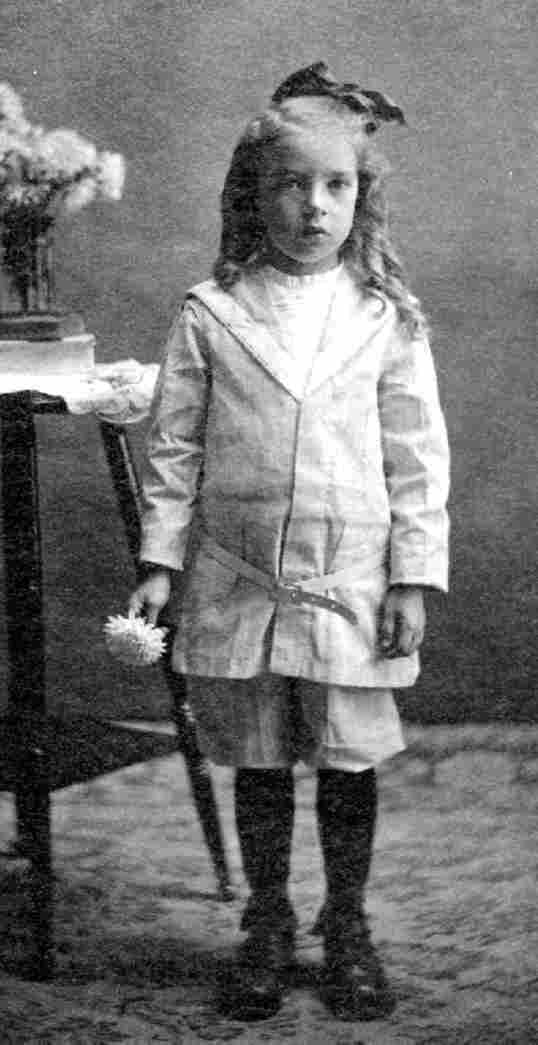
Ringlet Curls: Characteristics--Tightness

Figure 1.--This American boy was photographed about 1905 in a sailor tunic. He wears riglets that have either been loosely curled or had been curled a day or so earlier. Note how mother has laid the ringlets on his shoulder to show for best affect. Also note the colored hair bow. His curls are clearly ringlets, but they are not very tightly done ringlets.
|
Some boys have very tightly curled ringlet curls where each ringlet is very distinct. Other boys have hair where the ringlets are loosely curled. Their hair in some cases almost does not look like they are wearing ringlets curls. The hair looks like it is curled, only not in tight individual ringlets. HBC is unsure at this time as to whether this is a fashion and that the hair was curled for this effect or whether the hair might have been curled a day or so earlier and had lost their tight ringlet look. As some of the images of boys with these styles were potrait taken at a studio, you would have thought that their hair would have been done epecilally for the portrait, so it may have been the style and not ringlets that had lost their tight look. These loose curled curls have a rather informal look. This style may ave been more common after the turn of the century and the more formal tightly curled curls before the turn of the century. HBC has never seen a contemprary discussion of the tightness of ringlet curls in contemprary journals. This is another topic that HBC hopes to pursue.
Types
HBC has noted two basic types of riglet cirls in terms of tigtness. We are not able to determin, however, if the loose type was actually a style and not just tihjt ringlets that had loss their tight cyrled form.
Tight curls
Some boys have very tightly curled ringklet curls where each ringlet is very distinct. Much of the discussion of ringlets on HBC is of the tight curl style. As a result, we will not go into degail here about this type.
Other boys have hair where the ringlets are loosely curled. Their hair in some cases almost does not look like they are wearing ringlets curls. The hair looks like it is curled, only not in tight individual ringlets. HBC is unsure at this time as to whether this is a fashion and that the hair was curled for this effect or whether the hair might have been curled a day or so earlier and had lost their tight ringlet look. As some of the images of boys with these styles were potrait taken at a studio, you would have thought that their hair would have been done epecilally for the portrait, so it may have been the style and not ringlets that had lost their tight look.
Chronology
These loose curled curls have a rather informal look. This style may ave been more common after the turn of the century and the more formal tightly curled curls before the turn of the century. HBC has never seen a contemprary discussion of the tighness of ringlet curls in contemprary journals. This is another topic that HBC hopes to pursue.
Gender
HBC does not at this time whether it was more common for boys or girls to wear the tight or loose type of ringlet curls.
Hair Dressing
One reason that HBC is not able to fully assess ringlet curl styles is that we do not fully understand how hair was curled and what hair care products were available at any given period. One HB contributor wonders if there are different ways of forming ringlets. The boy in figure 1 looks like his were formed by wrapping the hair loosly around something, perhaps a rag. The curls look like a spiral rather than a hollow cylinder.
Christopher Wagner

Navigate the Boys' Historical Clothing hair style pages:
[Return to the Main ringlet characteristic page]
[Return to the Main long hair page]
[Return to the Main curl hair page]
[Bangs]
[Ringlet curls]
[Hair bows]
[Caps]
[Collar bows]
Navigate the Boys' Historical Clothing Web Site:
[Introduction]
[Activities]
[Biographies]
[Chronology]
[Clothing styles]
[Countries]
[Topics]
[Bibliographies]
[Contributions]
[FAQs]
[Glossaries]
[Satellite sites]
[Tools]
[Boys' Clothing Home]
Created: August 4, 2000
Last edited: December 19, 2002



